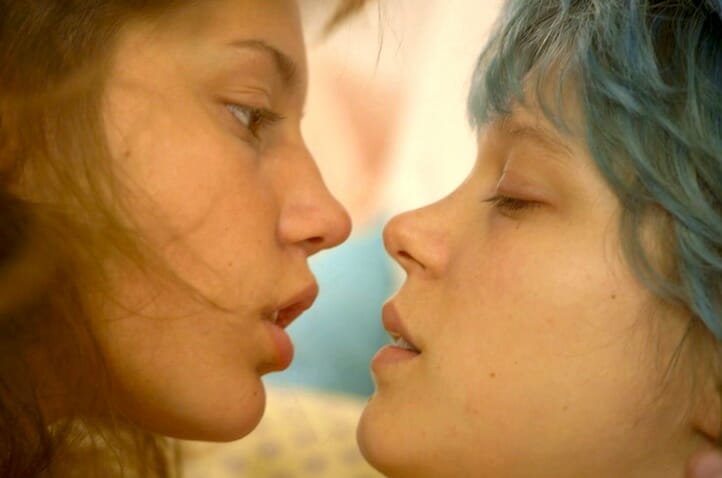
Three-hour movies usually are the terrain of Westerns, period epics or sweeping, tragic romances. They don’t tend to be intimate character pieces, but Blue Is the Warmest Color (La Vie D’Adèle Chapitres 1 et 2) more than justifies its length. A beautiful, wise, erotic, devastating love story, this tale of a young lesbian couple’s beginning, middle and possible end utilizes its running time to give us a full sense of two individuals growing together and apart over the course of years. It hurts like real life, yet leaves you enraptured by its power.
Blue Is the Warmest Color is a loose adaptation of a graphic novel by Julie Maroh. The filmmaker is Abdellatif Kechiche, who a few years ago produced The Secret of the Grain, one of the best recent foreign-language films. Blue is even better, tracing the maturation process of Adèle (Adèle Exarchopoulos), a high school girl who’s starting to have hormonal stirrings. But for whom? A male classmate seems to take an interest in her, but she doesn’t feel much of a connection. Then one day, while walking down the street, she passes a captivating woman with blue hair. They share a look but nothing more—until their paths cross again and Adèle learns that her name is Emma (Léa Seydoux). In college and more worldly and sophisticated than Adèle, Emma is gay and in a two-year relationship, which soon ends once Adèle and Emma begin a courtship.
Often incorporating a handheld, seemingly improvisational flair, Kechiche doesn’t try to elevate the importance of Adèle and Emma’s relationship. If the movie’s length is epic, Blue’s feel is modest but serious, the filmmaker laying out all the important moments in a love affair so that we feel like we really understand these two people. As its French title suggests, the movie is told from Adèle’s perspective, and much of the first hour is devoted to her slowly coming to terms with her attraction for a woman, a decision that’s not easy considering some of the bigots at her school and her possibly unsupportive parents who have no idea about her sexual questioning. All these scenes matter so that Kechiche can firmly establish who Adèle is—anxious, sensitive, sweet—before she enters Emma’s gravitational orbit. Otherwise, the impact wouldn’t be so great once we witness how Adèle changes thanks to falling in love with Emma.
The initial buzz around Blue Is the Warmest Color concerned not its love story but, rather, its explicit sex scenes. They do exist and are indeed explicit, but like everything else in this film, they’re incredibly intimate, revealing and essential to the overall tapestry that Kechiche is constructing. Perhaps not since Y Tu Mamá También has a movie’s sex scenes been so integral to story and character development. Charmed but also intimidated by Emma’s maturity and confidence, Adèle enters the relationship at something of a disadvantage, but the sex scenes allow them to gain an equal foothold, their bodies joined together in shared ecstasy. (There’s a reason why they need to be so explicit: We have to believe fully in these two people’s erotic connection, which is palatable, convincing and utterly unadorned.)
To reveal too much else of Blue’s storyline would be to rob the viewer of the gentle twists and shifts in the characters’ dynamic. But then again, a plot description really doesn’t do justice to the nuance of what Kechiche has achieved. In understated scene after understated scene, the movie organically chronicles how any relationship—straight or gay—evolves over time, skipping the usual loss-of-passion obviousness for something much more insightful. Some initial differences between the women are worked out over time. Others remain obstacles, threatening to upend their commitment. But unlike a more traditional romantic film, which runs less than two hours, Blue Is the Warmest Color never throws us by what the characters do because we understand their actions and recognize how a particular moment in the present is an echo of what happened earlier in the film. Kechiche’s movie requires patience, but that patience is rewarded by opening up a love affair to show how so much of our personal struggles—about growing up, about trying to trust another person, about getting over our own insecurities—are tangled up in our relationship with a partner.
Both actresses are simply exceptional. Seydoux is better known of the two thanks to appearances in Midnight in Paris, Inglourious Basterds and the most recent Mission: Impossible. She’s exquisite as Emma, a passionate painter who comes from an enlightened, culturally literate family but shows not a trace of arrogance—just a drive to be recognized for her art. Seydoux’s costar, Exarchopoulos, is the real revelation. Adèle may think she’s finding her soul mate in Emma, but really she’s going through an incredibly intricate coming-of-age, one that isn’t quite over after three hours of screen time. Their scenes together, especially near the beginning, are small marvels of realistic, wonderful talk that are delivered seemingly off-the-cuff, their rapport so instant and warm that you’re sure they’re meant to be a couple.
After Blue Is the Warmest Color ended, I still felt that way. Others may not come to the same conclusion, though, because of what life, adulthood, career aspirations and differing worldviews do to their bond. But what isn’t in doubt is how fortunate we are to spend such a significant amount of time with these two. If anything, Blue Is the Warmest Color isn’t long enough.
Director: Abdellatif Kechiche
Writers: Abdellatif Kechiche, Ghalia Lacroix; Julie Maroh (graphic novel)
Starring: Léa Seydoux, Adèle Exarchopoulos, Salim Kechiouche, Mona Walravens, Jérémie Laheurte, Alma Jodorowski, Aurélien Recoing, Catherine Salée
Release Date: Screening in the Official Competition at the 2013 Cannes Film Festival